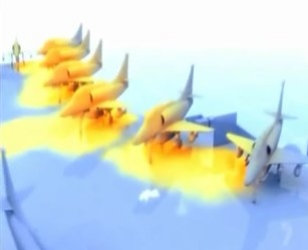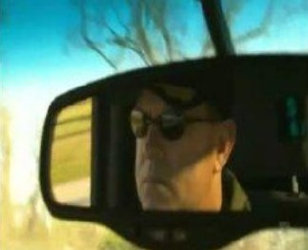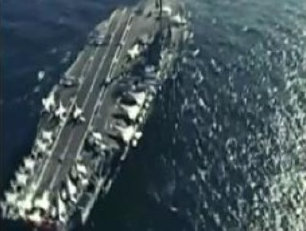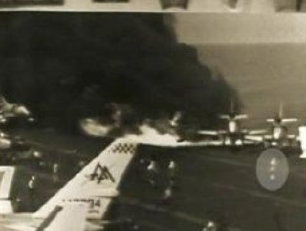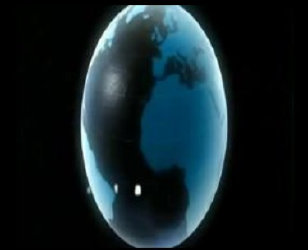



The Tragic Fire, July 29, 1967 10:52am
top
This is what is believed to be the last photo taken of the Forrestal on the morning of July 29, 1967
The ruptured tank spew highly flammable JP-5 fuel onto the deck which ignited spreading flames over the flight deck under other fully loaded aircraft ready for launch. The ensuing fire caused ordinance to explode and other rockets to ignite. Spread by the wind, the flames engulfed the aft end of the stricken ship turning the flight deck into a blazing inferno. Berthing spaces immediately below the flight deck became death traps for fifty men, while other crewmen were blown overboard by the explosion.
Nearby ships hastened to the Forrestal's aid.The Oriskany, herself a victim of a tragic fire in October 1966, stood by to offer fire-fighting and medical aid to the larger carrier.Nearby escort vessels sprayed water on the burning Forrestal and within an hour the fire on the flight deck was under control.But secondary fires below deck took another 12 hours to contain.The damage and loss of life was catastrophic.The four-and-a-half-acre flight deck was littered with pieces of aircraft, as men struggled to clear away bombs and ammunition, throwing the ordnance over the side.One young 130-pound lieutenant found the strength to heave a 250-pound bomb overboard.
Once the fire was finally under control, the time had come to tally up the loss of life and the damages. One hundred and thirty-four men had lost their lives, twenty-one aircraft were destroyed and forty-three others damaged. The cost to repair the carrier was reckoned at $72 million.The Forrestal made her way to the Philippines and then home, arriving at Norfolk on September 14.A special group, the Aircraft Carrier Safety Review Panel, was convened on August 15 to examine the problem of shipboard fires.The panel's findings were released on October 18, and among the recommendations made were: development of a remote-control fire-fighting system for the flight deck, development of more stable ordnance, improvement in survival equipment, and increased training in fire survival
Nearby ships hastened to the Forrestal's aid.The Oriskany, herself a victim of a tragic fire in October 1966, stood by to offer fire-fighting and medical aid to the larger carrier.Nearby escort vessels sprayed water on the burning Forrestal and within an hour the fire on the flight deck was under control.But secondary fires below deck took another 12 hours to contain.The damage and loss of life was catastrophic.The four-and-a-half-acre flight deck was littered with pieces of aircraft, as men struggled to clear away bombs and ammunition, throwing the ordnance over the side.One young 130-pound lieutenant found the strength to heave a 250-pound bomb overboard.
Once the fire was finally under control, the time had come to tally up the loss of life and the damages. One hundred and thirty-four men had lost their lives, twenty-one aircraft were destroyed and forty-three others damaged. The cost to repair the carrier was reckoned at $72 million.The Forrestal made her way to the Philippines and then home, arriving at Norfolk on September 14.A special group, the Aircraft Carrier Safety Review Panel, was convened on August 15 to examine the problem of shipboard fires.The panel's findings were released on October 18, and among the recommendations made were: development of a remote-control fire-fighting system for the flight deck, development of more stable ordnance, improvement in survival equipment, and increased training in fire survival
With the war in Southeast Asia providing experience for all phases of naval operations, several carriers which normally belong to the Atlantic Fleet were occasionally routed to WESTPAC duty, and thus it was that on June 6, 1967,
Forrestal left Norfolk, Virginia, for what was to be her first combat deployment.Carrying Air Wing 17, Forrestal was the first U.S. carrier to be built from the keel up with an angled deck.
She carried East Coast squadrons, two F-4B squadrons squadrons; VF-11 and VF74; VA-106 and VA-46, flying A-4Es; RVAH-11, with RA-5C Vigilantes, for which the big carrier had undergone major modification for the IOIC reconnaissance intelligence system; the KA-3Bs of VAH-10; and VAW-123, flying E-2As.
Forrestal arrived on Yankee Station on July 25 and immediately began combat operations, her aircraft flying 150 sorties during the next 4 days, without the loss of a single aircraft. At 10:52 A.M. on July 29, the second launch was being readied when a Zuni rocket accidentally fired from an F-4 Phantom parked on the starboard side of the flight deck aft of the island.The missile streaked across the deck into a 400 gallon belly fuel tank on a parked A-4D Skyhawk.
Forrestal left Norfolk, Virginia, for what was to be her first combat deployment.Carrying Air Wing 17, Forrestal was the first U.S. carrier to be built from the keel up with an angled deck.
She carried East Coast squadrons, two F-4B squadrons squadrons; VF-11 and VF74; VA-106 and VA-46, flying A-4Es; RVAH-11, with RA-5C Vigilantes, for which the big carrier had undergone major modification for the IOIC reconnaissance intelligence system; the KA-3Bs of VAH-10; and VAW-123, flying E-2As.
Forrestal arrived on Yankee Station on July 25 and immediately began combat operations, her aircraft flying 150 sorties during the next 4 days, without the loss of a single aircraft. At 10:52 A.M. on July 29, the second launch was being readied when a Zuni rocket accidentally fired from an F-4 Phantom parked on the starboard side of the flight deck aft of the island.The missile streaked across the deck into a 400 gallon belly fuel tank on a parked A-4D Skyhawk.


USS Forrestal
Prelude to Disaster (9:58)
Prelude to Disaster (9:58)
USS Forrestal
The Fire (9:41)
The Fire (9:41)
USS Forrestal
The Investigation (9:24)
The Investigation (9:24)
USS Forrestal
What Went Wrong (5:17)
What Went Wrong (5:17)
USS Forrestal
Final Report (6:01)
Final Report (6:01)
